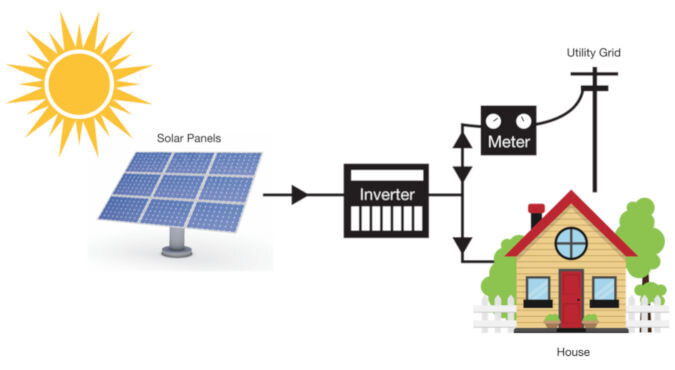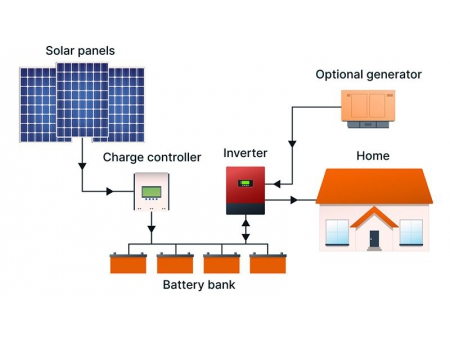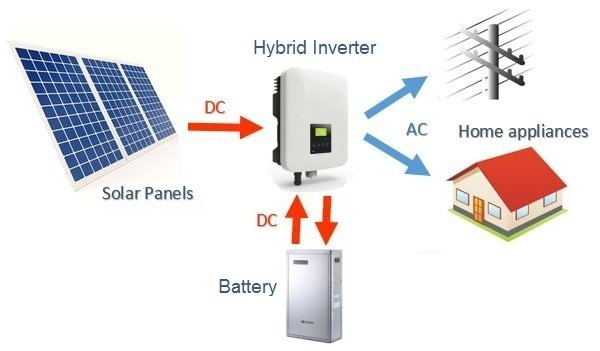Conclusion
1. Grid-Tied Solar System
2. Off-Grid Solar System
3. Hybrid Solar System
Key Factors to Consider
Conclusion
When deciding to switch to solar energy, choosing the right solar power system is a crucial step. With various options available in the market, understanding which solar system suits your specific needs can help you save both money and energy in the long run. Here, we’ll explore the three main types of solar systems: grid-tied, off-grid, and hybrid systems, helping you determine which one might be best for your situation.

A grid-tied solar system is connected directly to the local utility grid. This is the most common type of solar system for homes and businesses.
Advantages:
- Cost-Effective: Grid-tied systems typically have lower upfront costs since you don’t need to purchase batteries for energy storage.
- Energy Backup from the Grid: If your solar panels aren’t generating enough energy, you can pull electricity from the grid.
- Net Metering: In some regions, you can sell excess energy back to the grid, reducing your electricity bills even further.
Who Is It For?
A grid-tied system is ideal for homeowners and businesses in areas with reliable grid access and favorable net metering policies. If you are mainly looking to reduce your energy costs without the need for energy independence, this system is a good choice.

An off-grid solar system operates independently of the utility grid. It requires a solar battery to store excess energy for use during times when the sun isn’t shining, such as at night or during cloudy days.
Advantages:
- Energy Independence: You are completely self-sufficient and not affected by grid outages.
- Remote Locations: Ideal for properties located in remote areas where grid access is limited or unavailable.
Who Is It For?
Off-grid systems are perfect for people living in remote areas without access to a utility grid or for those seeking complete energy independence. However, the initial investment is typically higher due to the need for battery storage and a larger solar array to ensure consistent energy availability.

A hybrid solar system combines the benefits of both grid-tied and off-grid systems. It is connected to the grid but also includes a battery storage system. This way, you can store excess energy for use during outages or at night.
Advantages:
- Energy Flexibility: You can use stored energy when needed and still rely on the grid during low solar production periods.
- Backup Power: Provides peace of mind during blackouts, ensuring continuous electricity supply.
- Better Energy Utilization: With stored energy, you can reduce your reliance on grid power during peak rate hours.
Who Is It For?
Hybrid systems are ideal for homeowners and businesses who want the reliability of grid power with the added security of battery storage. It’s a great option for areas prone to power outages or for those seeking to maximize their energy savings by using stored solar energy during peak times.
1. Location
If you live in an area with frequent grid outages or limited access to the grid, an off-grid or hybrid system might be better suited for you. On the other hand, if grid access is stable and reliable, a grid-tied system may be the most cost-effective solution.
2. Energy Needs
Analyze your energy consumption patterns. If your energy usage is high during peak hours, a hybrid system can help you reduce reliance on expensive grid power by using stored solar energy.
3. Budget
Your budget plays a significant role in determining which solar system is best for you. While grid-tied systems have the lowest initial costs, off-grid and hybrid systems require more upfront investment but offer greater independence and long-term savings in the right circumstances.
4. Future Expansion
Consider if you might want to expand your solar capacity in the future. Hybrid systems offer more flexibility for expansion compared to grid-tied and off-grid systems.
Choosing the right solar system depends on your unique energy requirements, location, budget, and personal preferences. A grid-tied system is often the most practical and cost-effective for those with reliable grid access, while an off-grid system is suitable for remote locations or individuals seeking energy independence. A hybrid system offers the best of both worlds, providing energy flexibility and reliability.
By carefully assessing your needs and understanding the different types of solar systems available, you can make an informed decision that will benefit you in the long term, ensuring efficient energy use and savings.








